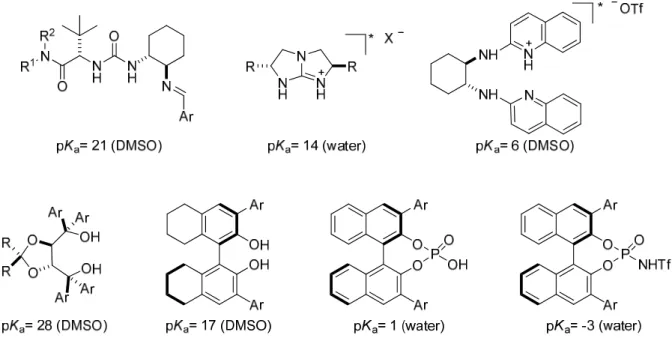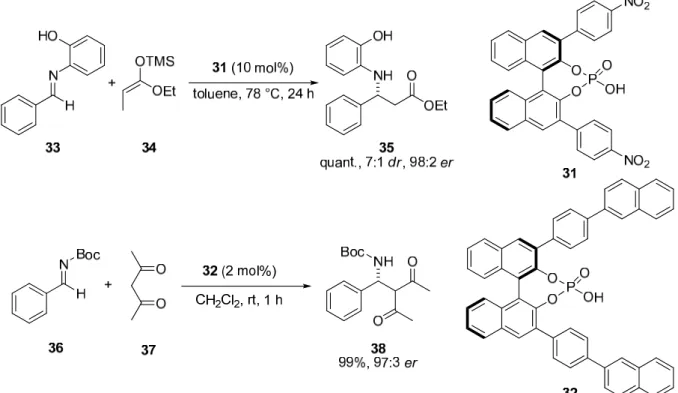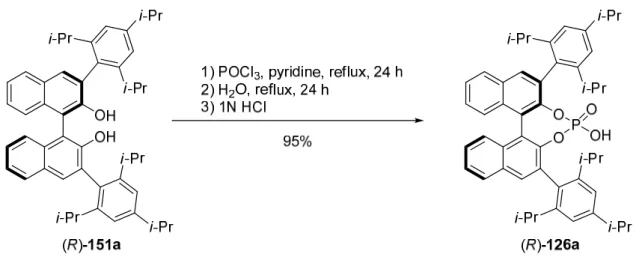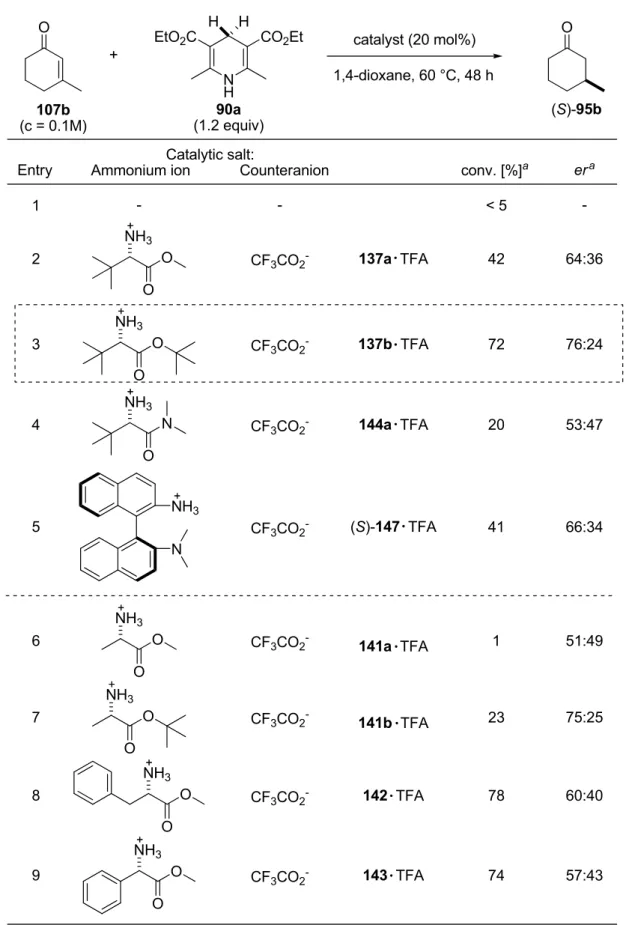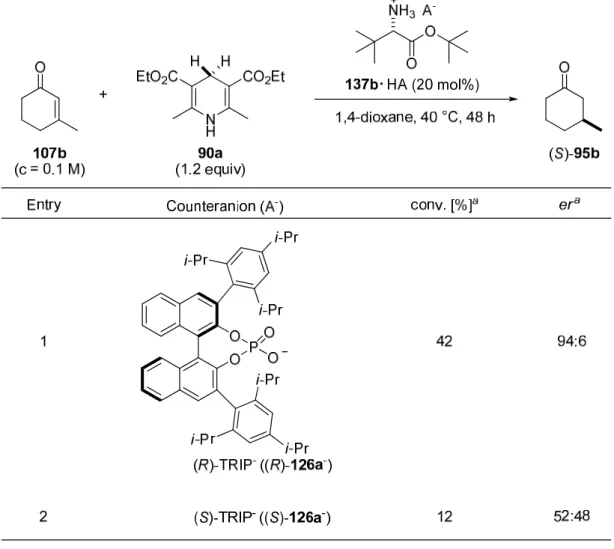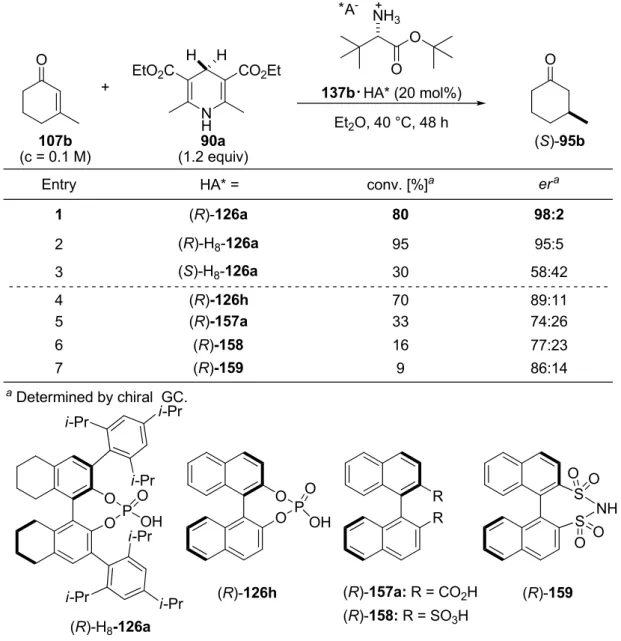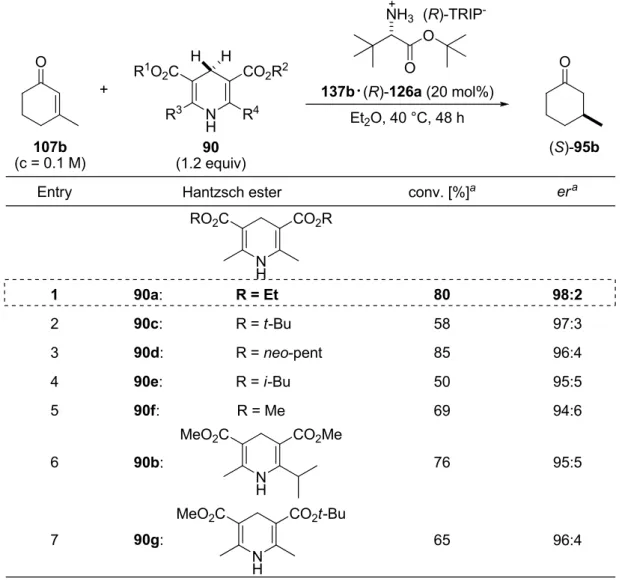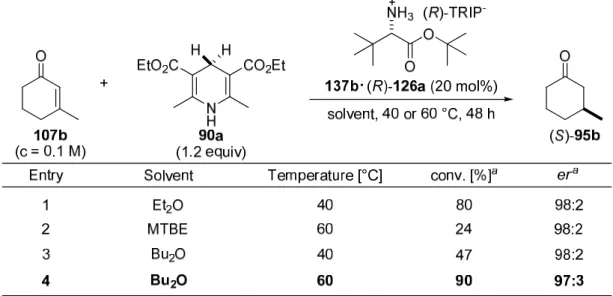Transfer Hydrogenations of Olefins
New Catalytic Routes to Saturated ȕ-Branched Ketones, ȕ,ȕ-Disubstituted Nitroalkanes as well as ȕ-Nitroesters as Precursors of ȕ-Amino Acids
,QDXJXUDO'LVVHUWDWLRQ
=XU
(UODQJXQJGHV'RNWRUJUDGHV
GHU0DWKHPDWLVFK1DWXUZLVVHQVFKDIWOLFKHQ)DNXOW¦W
GHU8QLYHUVLW¦W]X.¸OQ
YRUJHOHJWYRQ 1ROZHQQ-$0DUWLQ DXV&OXVHV)UDQNUHLFK
.¸OQ
II
Tag der mündlichen Prüfung: 03. März 2009
III
This work describes the successful development of highly efficient and enantioselective organocatalytic approaches to the synthesis of chiral ȕ-substituted ketones, ȕ,ȕ-disubstituted nitroalkanes as well as ȕ-nitroesters. The latter could be efficiently converted to the corresponding ȕ
2-amino acids. Inspired by the in vivo enzymatic conjugate reductions with NAD(P)H cofactors, we established biomimetic transfer hydrogenations, for which dihydropyridines and organocatalysts were employed as NAD(P)H and enzyme analogues, respectively.
The asymmetric conjugate reduction of enones was achieved via iminium catalysis using a salt composed of a protonated valine tert-butyl ester and a chiral BINOL phosphate counteranion.
The process was particularly well-suited for cyclic Į,ȕ-unsaturated ketones. Acyclic enones could also be successfully used, although yielding the products with slightly lower enantioselectivities.
A Jacobsen-type thiourea efficiently catalyzed the transfer hydrogenation of ȕ,ȕ-disubstituted nitroalkenes via hydrogen bonding catalysis. The reaction had a broad substrate scope and a number of aromatic and aliphatic nitroalkenes could be utilized.
Moreover, we successfully established a concise new strategy to enantioenriched ȕ
2-amino acids.
The key step in this process was a highly enantioselective and efficient thiourea-catalyzed
conjugate reduction of ȕ-nitroacrylates to the saturated analogues. The nitroesters were then
easily and efficiently converted into the corresponding ȕ
2-amino acids. In addition, a convenient
synthesis of the required ȕ-nitroacrylates via a Henry reactiondehydration process was
developed.
IV
Diese Arbeit beschreibt die erfolgreiche Entwicklung hocheffizienter and enantioselektiver organokatalytischer Verfahren zur Synthese chiraler ȕ-substituierter Ketone, ȕ,ȕ-disubstituierter Nitroalkane sowie ȕ-Nitroester. Die letzteren konnten direkt zu den entsprechenden ȕ
2- Aminosäuren umgesetzt werden. In Anlehnung an die enzymatischen konjugierten Reduktionen mit dem NAD(P)H-Cofaktor in vivo wurden biomimetische Transferhydrierungen unter Verwendung von Dihydropyridinen und Organokatalysatoren als NAD(P)H- und Enzymanaloga entwickelt.
Die asymmetrische konjugierte Reduktion Į,ȕ-ungesättigter Ketone wurde mit Hilfe von Iminiumkatalyse unter Einsatz eines Salzes des protonierten Valin-tert-butylesters in Kombination mit einem chiralen BINOL-phosphat-Gegenion erreicht. Diese Methode erwies sich für zyklische Ketone als besonders geeignet. Auch azyklische Į,ȕ-ungesättigte Ketone konnten erfolgreich verwendet werden, aber lieferten die Produkte mit leicht geringeren Enantioselektivitäten.
Ein Jacobsen-artiges Thioharnstoffderivat katalysierte die Transferhydrierung ȕ,ȕ-disubstituierter Nitroalkene über die Ausbildung von Wasserstoffbrückenbindungen. Eine Vielzahl aromatischer und aliphatischer Substrate wurde mit hohen Ausbeuten und Enantioselektivitäten zu den entsprechenden Nitroalkanen reduziert.
Außerdem wurde eine neue Strategie für den schnellen Zugang zur enantiomerenangereicherten
ȕ
2-Aminosäuren erfolgreich entwickelt. Den zentralen Schritt dieses Prozesses stellte eine
hochenantioselektive und vielseitige Thioharnstoff-katalysierte konjugierte Reduktion von ȕ-
Nitroacrylaten dar. Die erhaltenen ȕ-Nitroester konnten anschließend leicht zu den
entsprechenden ȕ
2-Aminosäuren umgesetzt werden. Zusätzlich wurde eine praktische Methode
zur Herstellung der ȕ-Nitroacrylate über eine Henry-Reaktion gefolgt von einer Dehydrierung
entwickelt.
V
TABLE OF STRUCTURES……….. X
ABBREVIATIONS……… XXVI ACKNOWLEDGEMENTS………... XXXI
1 INTRODUCTION………... 1
2 BACKGROUND………. 4
2.1 Asymmetric Organocatalysis……….. 4
2.1.1 Types of Organocatalysis……….. 5
2.1.1.1 Lewis base catalysis ……… 5
2.1.1.2 Lewis acid catalysis ……… 8
2.1.1.3 Brønsted base catalysis ………... 9
2.1.1.4 Brønsted acid catalysis ……….... 10
2.1.2 Iminium Catalysis ……… 15
2.1.3 Hydrogen Bonding Catalysis and (Thio)urea Catalysts……… 18
2.1.3.1 Early Successes: From Biphenylenediols to Efficient N,N'- Diaryl(thio)urea Catalysts……….. 19
2.1.3.2 Chiral (Thio)ureas for Asymmetric Organocatalysis………... 20
2.2 Transfer Hydrogenation Using Hantzsch Esters: a Biomimetic Approach……... 27
2.2.1 Hydrogenation Processes of Unsaturated Compounds………... 27
2.2.2 Nature’s Enantioselective Hydrogenation Strategies……….. 28
2.2.3 Hantzsch Esters as Biomimetic Reducing Agents……….. 30
2.3 Enantioselective Synthesis of ȕ , ȕ -Disubstituted Saturated Ketones……… 31
2.3.1 Asymmetric Conjugate Addition to ȕ-Branched Enones……….. 31
2.3.2 Asymmetric Conjugate Reduction of ȕ,ȕ-Disubstituted Enones……….. 33
2.3.2.1 Asymmetric Hydrogenation………. 33
2.3.2.2 Asymmetric Transfer Hydrogenation……….. 34
2.3.2.3 Asymmetric Hydrosilylation……… 35
2.4 Enantioselective Synthesis of ȕ,ȕ-Disubstituted Nitroalkanes and ȕ-Nitroesters... 37
2.4.1 Asymmetric Conjugate Addition to ȕ-Branched Nitroolefins……….. 37
2.4.2 Asymmetric Conjugate Reduction of ȕ,ȕ-Disubstituted Nitroolefins…………... 38
2.4.3 ȕ-Nitroacrylates as Precursors of ȕ²-Amino Acids………... 39
3 BACKGROUND AND OBJECTIVES OF THIS Ph.D. WORK………... 41
3.1 Enantioselective Transfer Hydrogenation of Į , ȕ -Unsaturated Ketones………... 43
3.2 Enantioselective Transfer Hydrogenation of ȕ , ȕ -Disubstituted Nitroolefins……. 44
3.3 Enantioselective Transfer Hydrogenation of ȕ-Nitroacrylates: A Route to ȕ²- Amino Acids……….. 47
4 RESULTS AND DISCUSSIONS………... 50
4.1 Synthesis of Ammonium Salt Organocatalysts………. 50
4.1.1 Synthesis of Amino Acid Derivatives………... 50
VI
4.1.2 Synthesis of Other Primary Amines……….…. 53
4.1.3 Synthesis of BINOL-Derived Phosphates……….… 54
4.1.3.1 Synthesis of BINOL-Derived Phosphates via Suzuki Cross-Coupling…... 55
4.1.3.2 Synthesis of BINOL-Derived Phosphates via Kumada Cross-Coupling…. 56 4.1.4 Other Chiral Amines and Chiral acids……….. 59
4.1.5 Preparation of the Amino Acid-Derived Salts……….. 59
4.2 Synthesis of (Thio)urea Organocatalysts………... 60
4.2.1 Preparation of Mono(thio)urea Catalysts……….. 61
4.2.2 Preparation of Jacobsen-Type Monothiourea Catalysts………... 63
4.2.2.1 Synthesis of Jacobsen(-Type) Thioureas 58e and 50g……….... 63
4.2.2.2 Synthesis of Jacobsen(-Type) Thioureas 57a-l………... 65
4.2.2.3 Synthesis of Jacobsen-Type Thiourea 176……….. 67
4.2.3 Preparation of Bisthiourea Catalysts………. 67
4.2.4 Other Hydrogen Bonding Organocatalysts………... 69
4.2.5 Discussion of the Results……….. 69
4.3 Enantioselective Transfer Hydrogenation of Į,ȕ-Unsaturated Ketones…………. 71
4.3.1 Synthesis of the Starting Materials and Racemic Products………... 71
4.3.1.1 Synthesis of the Į,ȕ-Unsaturated Cyclic Ketones……….... 71
4.3.1.2 Synthesis of the Į,ȕ-Unsaturated Acyclic Ketones……….. 73
4.3.1.3 Synthesis of the Racemic Products……….. 75
4.3.2 Development and Optimization of the Catalytic System……….. 76
4.3.2.1 Identification of the Catalyst’s Core Structural Motif………. 76
4.3.2.2 Determination of the Counteranion Effect and Motif……….. 80
4.3.2.3 First Solvent Screening……….... 82
4.3.2.4 Optimization of the Chiral Counteranion………. 83
4.3.3 Optimization of the Reaction Conditions……….. 86
4.3.3.1 Hantzsch Ester Structure and Concentration……….... 86
4.3.3.2 Solvent and Temperature………. 88
4.3.3.3 Catalyst Loading……….. 89
4.3.3.4 Substrate Concentration………... 90
4.3.3.5 Final Catalyst Optimization………. 91
4.3.4 Investigation of the Reaction Scope……….. 93
4.3.4.1 Scope of the Catalytic Reaction………... 93
4.3.4.2 Effect of the Enone Geometry………. 95
4.3.4.3 Extension to More Complex Substrates………... 96
4.3.4.4 Effect of an Į-Substituent……….... 97
4.3.5 Scale-Up of the Transfer Hydrogenation……….. 97
4.3.6 Mechanistic Considerations………... 99
4.3.7 Conclusion and Discussion………... 104
4.4 Enantioselective Transfer Hydrogenation of ȕ,ȕ-Disubstituted Nitroalkenes….... 107
4.4.1 Synthesis of the Nitroolefins and Racemic Products……….... 107
4.4.1.1 Synthesis of the Nitroolefins via Nitration……….. 107
4.4.1.2 Investigations to Optimize the Nitroolefin Preparation………... 108
4.4.1.3 Synthesis of the Racemic Nitroalkanes……….... 111
4.4.2 Identification of the Catalyst’s Core Structural Motif……….. 112
4.4.2.1 Evaluation of the Catalyst Motif……….. 112
VII
4.4.3 Optimization of the Catalyst and Reaction Conditions………. 117
4.4.3.1 Optimization of the Solvent………. 117
4.4.3.2 Hantzsch Ester Structure and Concentration……….... 119
4.4.3.3 Optimization of Jacobsen(-Type) Thiourea Catalyst………... 120
4.4.3.4 Catalyst Loading……….. 123
4.4.3.5 Substrate Concentration………... 124
4.4.4 Investigation of the Reaction Scope……….. 125
4.4.5 Mechanistic Considerations……….. 129
4.4.6 Conclusion and Discussion………... 135
4.5 Enantioselective Transfer Hydrogenation of ȕ -Nitroacrylates: a Route to ȕ ²- Amino Acids……….. 137
4.5.1 Synthesis of the Starting Materials and Racemic Products………... 137
4.5.1.1 Synthesis of the ȕ-Nitroacrylates………. 137
4.5.1.2 Investigations to Optimize the Preparation of ȕ-Nitroacrylates…………... 140
4.5.1.3 Synthesis of the Racemic ȕ-Nitroesters………... 144
4.5.2 Determination and Optimization of the Catalyst Structure………... 146
4.5.3 Optimization of the Reaction Conditions……….. 149
4.5.3.1 Optimization of the Solvent………. 149
4.5.3.2 Optimization of the Hantzsch Ester Structure and Concentration………... 150
4.5.3.3 Effect of the Temperature on the Catalysis……….. 152
4.5.3.4 Optimization of the Catalyst Loading and the Substrate Concentration….. 153
4.5.3.5 Optimization of the Work-Up of the Reaction………. 155
4.5.4 Investigation of the Reaction Scope……….. 156
4.5.5 Development of a Stereoconvergent Process……….... 158
4.5.6 Transfer Hydrogenation of ȕ-Nitroacrylates: a Route to ȕ²-Amino Acids……... 160
4.5.7 Mechanistic Considerations……….. 161
4.5.8 Conclusion and Discussion………... 162
5 SUMMARY………. 165
6 OUTLOOK……….. 171
6.1 Transfer Hydrogenation of Į,ȕ-Unsaturated Ketones……… 172
6.2 Transfer Hydrogenation of ȕ,ȕ-Disubstituted Nitroalkenes………... 174
6.3 Transfer Hydrogenation of ȕ-Nitroacrylates: a Route to ȕ²-Amino Acids………….... 177
7 EXPERIMENTAL PART……….. 179
7.1 General Experimental Conditions……….. 179
7.1.1 General mode of operation……….... 179
7.1.2 Analytical Methods………... 180
7.2 Synthesis of Organocatalysts for the Transfer Hydrogenation of Enones………. 183
7.2.1 Synthesis of Amino Esters……….... 183
7.2.1.1 Synthesis of L-tert-Leucine Methyl Ester (137a)... 183
7.2.1.2 Synthesis of L-tert-Leucine tert-Butyl Ester (137b)……… ……... 184
7.2.1.3 Synthesis of L-Valine tert-Butyl Ester (139a)……… ……… 185
7.2.1.4 Preparation of Free Amino Esters from their Corresponding
Hydrochloride Salts (139a) ………... 185
VIII
7.2.2.2 Synthesis of (S)-N ,N -dimethyl-1,1'-binaphthyl-2,2'-diamine ((S)-147).. 189
7.2.3 Synthesis BINOL Derived (R)-TRIP ((R)-126a)………… ………. 191
7.3 Synthesis of Hydrogen Bonding (Thio)ureas………. 196
7.3.1 Synthesis of Mono(thio)ureas………... 196
7.3.1.1 Synthesis of 1,3-bis(3,5-bis(trifluoromethyl)phenyl)thiourea (49b)……... 196
7.3.1.2 Synthesis of 1-(3,5-bis(trifluoromethyl)phenyl)-3-((1R,2S)-2-hydroxy- 2,3-dihydro-1H-inden-1-yl)thiourea (162)……… ……….. 197
7.3.1.3 Synthesis of (S)-2-(3-(3,5-bis(trifluoromethyl)phenyl)thioureido)- N,N,3,3-tetramethylbutanamide (164a)……… ……….. 197
7.3.1.4 (S)-1-(3,5-bis(trifluoromethyl)phenyl)-3-(2'-(dimethylamino)-1,1'- binaph-thyl-2-yl)thiourea (76)………… ……… 198
7.3.1.5 (S)-tert-Butyl 1-(3-(3,5-bis(trifluoromethyl)phenyl)ureido)-2,2-dimethyl- propylcarbamate (165)………… ……… 199
7.3.1.6 tert-Butyl-(S)-1-(3-((1R,2R)-2-(2,5-dimethyl-1H-pyrrol-1-yl)cyclohexyl)- ureido)-2,2-dimethylpropylcarbamate (168)……… …………... 200
7.3.2 Synthesis of Jacobsen-Type Monothioureas………... 202
7.3.2.1 Synthesis of L-tert-Leucine Derived Amides (144a-d)……… …….. 202
7.3.2.2 Synthesis of Pyrrolylcyclohexanamine Derivatives (169a-d)……… …… 204
7.3.2.3 Synthesis of (S)-2-(3-((1R,2R)-2-Aminocyclohexyl)thioureido)-N,N- diethyl-3,3-dimethylbutanamide (58e)... 207
7.3.2.4 Synthesis of Jacobsen(-Type) Thiourea 50g………... 208
7.3.2.5 Synthesis of Jacobsen(-Type) Thioureas 57a-l………... 210
7.3.2.6 Synthesis of (S)-N,N-Diethyl-3,3-dimethyl-2-(3-phenylthioureido)butan- amide (176)……… ……… 220
7.3.3 Synthesis Bisthioureas……….. 221
7.3.3.1 (S)-1,1'-(1,1'-binaphthyl-2,2'-diyl)bis(3-(3,5-bis(trifluoromethyl)phenyl)- thiourea) (178)… ………. 221
7.3.3.2 1,1'-((1R,2R)-Cyclohexane-1,2-diyl)bis(3-(3,5- bis(trifluoromethyl)phenyl)-thiourea) (63)…… ………... 222
7.3.3.3 1,1'-(1,3-Phenylenebis(methylene))bis(3-((1R,2R)-2-(2,5-dimethyl-1H- pyrrol-1-yl)cyclohexyl)thiourea) (180)……… ………... 222
7.4 Enantioselective Transfer Hydrogenation of Į,ȕ-Unsaturated Ketones…………. 224
7.4.1 Synthesis of the Starting Materials………... 224
7.4.1.1 Synthesis of the Į,ȕ-Unsaturated Cyclic Ketones 107………. 224
7.4.1.2 Synthesis of the Į,ȕ-Unsaturated Acyclic Ketones 113c………. 229
7.4.2 General Procedure for the Synthesis of the Racemic Products………. 231
7.4.3 Asymmetric Transfer Hydrogenation of Į,ȕ-Unsaturated Ketones……….. 232
7.5 Enantioselective Transfer Hydrogenation of ȕ , ȕ -Disubstituted Nitroalkenes…… 239
7.5.1 Synthesis of the Starting Materials………... 239
7.5.1.1 Synthesis of the Nitroolefins 120a-m………... 239
7.5.1.2 Synthesis of (E)-2-(Furan-2-yl)-1-nitro-1-propene (120n)……… ………. 248
7.5.2 General Procedures for the Synthesis of the Racemic Products………... 249
7.5.3 Asymmetric Transfer Hydrogenation of ȕ,ȕ-Disubstituted Nitroalkenes………. 250
7.6 Enantioselective Transfer Hydrogenation of ȕ-Nitroacrylates: a Route to ȕ²- Amino Acids……….. 256
7.6.1 Synthesis of the Starting Materials………... 256
IX
7.6.1.3 Synthesis of the ȕ-nitroacrylates 121………... 265
7.6.2 General Procedures for the Synthesis of the Racemic Products………... 274
7.6.3 Asymmetric Transfer Hydrogenation of ȕ,ȕ-Disubstituted Nitroalkenes………. 275
7.6.4 Preparation of ȕ²-Amino Acids via Hydrogenation of ȕ-Nitroesters………... 282
7.6.4.1 Preparation of ȕ²-Amino Acid 122f via Hydrogenation……….. 282
7.6.4.1 Preparation of ȕ²-Amino Acids via a hydrogenationhydrolysis sequence. 283 8 REFERENCES………... 285
9 APPENDIX……….. 297
9.1 Erklärung……….. 297
9.2 Lebenslauf………. 298
X
N° Corresponding Compound N° Corresponding Compound
1 10
NH
CO2Me
2 11
O
O
Me
OH
3
O
H 12
4 13
H O
5 14
6 15
7 16
8 17
9
O O
O Me
18
XI
19 26
H
N Ph
Ph
20 27
CN
HN Ph
Ph
21
CO2Et
O 28
22 29
23 30
24
OH O
OEt 31
25 32
XII
33
H N HO
40
34 41
35 42
36 43
37 44
38 45
39 46
XIII
47 54
48 55
49 56
50 57
N N
O H R2
R1
NH S
57a: R1= R2= R3= R4= Me 57b: R1= R2= Et, R3= R4= Me 57c: R1= R2= Bn, R3= R4= Me 57d: R1= R2=n-Pr, R3= R4= Me 57e: R1= Bn, R2= Me, R3= R4= Me 57f: R1= Bn, R2= H, R3= R4= Me 57g: R1= R2= Et, R3= R4= Et 57h: R1= R2= Et, R3= Me, R4= Ph 57i: R1= R2= Et, R3= R4= Ph 57j: R1= R2= Bn, R3= R4= Et 57k: R1= R2= Bn, R3= Me, R4= Ph 57l: R1= R2= Bn, R3= R4= Ph
R3 N R4
51 58
52 59
53 60
XIV
61 70
62 71
63 72
64
O
H 73
65
O
74
66
O R
OH
66a: R = Ph
66b: R = Cy 75
67 76
68 77
69 78
N
NH N R
H OMe
NH Ar X
Ar = 3,5-(CF3)2-C6H3 78a: R = CH=CH2 79a:X = S 78b: R = CH2CH3 79a:X = O
XV
79 86
80 87
81 88
82 89
83 90
84 91
85 92
O OH HO
XVI
93
N R O2C
R4 R3
CO2R
93a: R1= R2= Et, R3= R4= Me 93b: R1= R2= Et, R3= Me, R4=i-Pr 93c: R1= R2=t-Bu, R3= R4= Me 93d: R1= R2=i-Bu, R3= R4= Me 93e: R1= R2=neo-pent, R3= R4= Me 93f: R1= R2= Me, R3= R4= Me 93g: R1= Me, R2=t-Bu, R3= R4= Me 93h: R1= R2= Me, R3= R4= Et 93i: R1= R2= Me, R3= R4=n-Pr 93j: R1= R2= Me, R3= R4= Ph
100 O
O P N / Cu(OTf)2
i-Pr i-Pr
94 101
95 102
96 103
97
N O S
Cu i-Pr
104
98 105
99 106
XVII
107 113
108 114
109 115
110 116
R R' NO2
116a: R = C6H5, R' = Me 116b: R = C6H5, R' =i-Pr 116c: R = C6H5, R' = Et 116d: R = C6H5, R' =n-Pr 116e: R = 2-naphthyl, R' = Me 116f: R =p-Me-C6H5, R' = Me 116g: R =p-CN-C6H5, R' = Me 116h: R =p-F-C6H5, R' = Me 116i: R =p-Cl-C6H5, R' = Me 116j: R =m-Cl-C6H5, R' = Me 116k: R =o-Cl-C6H5, R' = Me 116l: R =t-Bu, R' = Me 116m: R = Et, R' = Me 116n: R = 2-furyl, R' = Me
111 117
112
P P
(R)-DTBM-SEGPHOS O
O O O
OMe
OMe
2
2
t-Bu
t-Bu
t-Bu
t-Bu 118
XVIII
122 122a:-fR = Me
12b-f: R = Ph R CO2H
NH2
119
123
124
120
R R' NO2
120a: R = C6H5, R' = Me 120b: R = C6H5, R' =i-Pr 120c: R = C6H5, R' = Et 120d: R = C6H5, R' =n-Pr 120e: R = 2-naphthyl, R' = Me 120f: R =p-Me-C6H5, R' = Me 120g: R =p-CN-C6H5, R' = Me 120h: R =p-F-C6H5, R' = Me 120i: R =p-Cl-C6H5, R' = Me 120j: R =m-Cl-C6H5, R' = Me 120k: R =o-Cl-C6H5, R' = Me 120l: R =t-Bu, R' = Me 120m: R = Et, R' = Me 120n: R = 2-furyl, R' = Me
125
NH O
121 126
XIX
127 136 OH
O NH2
128 137 O
O NH2
R 137a: R = Me 137b: R =t-Bu
129 138
130 H
O
Bn
139
131 N
OMe
Bn
Ph 140
132 141
133
CO2H R
O
142
134 143
135
R' CO2R O
139a:R = Me; R' = Et 139b:R = C6H5; R' =i-Pr 139c:R = C6H5; R' = Me 139d:R = C6H5; R' = Et 139e:R = C6H5; R' =t-Bu 139f:R = C6H5; R' = Bn 139g:R =p-Me-C6H4; R' = Et 139h:R =p-MeO-C6H4; 139h:R' = Et
139i:R =p-F-C6H4; R' = Et 139g:R =p-Cl-C6H4; R' = Et 139k:R =p-MeO-C6H4; 139k:R' =t-Bu
139l:R =p-F-C6H4; R' =t-Bu 139m:R = 2-thienyl; R' = Et 139n:R =n-Pent; R' = Et 139o:R =i-Pr; R' = Et
144
R1= R2= Me R1= R2= Et R1= R2= Bn R1= R2=n-Pr R1= Bn, R2= Me R1= Bn, R2= H
N NH2
O R2
R1
144a:1 144b:1 144c:1 144d:1 144e:1 144f:1
XX
145 152 OH
OH
146 153 OMe
OMe
147
NH2 N
154
B(OH)2
B(OH)2
OMe OMe
148 155
Br
Br OMe OMe
149 NHAc
NH2
156
i-Pr i-Pr
i-Pr BrMg
150 NHAc
NMe2 157
CO2H CO2H R
R 157a: R = H
157b: R = 3,5-(CF3)2-C6H3
151 158
XXI
159 S
S NH O O
O O
167
160 168
161 169
162 170
OH t-Bu
OCOt-Bu H O
163 171
164
CF3
F3C N
H N
H S
164a: R = NMe2
164b: R = OH
R O t-Bu
172
OH t-Bu
OCOt-Bu
165 173
OH t-Bu
OH
166 N3
O NH O
O 174
XXII
175 R1 O
R2 O
175a: R1= R2= Me 175b: R1= R2= Et 175c: R1= Me, R2= Ph 175d: R1= R2= Ph
182
176 183
177 184
O
n O
184a: n = 1 184b: n = 0 184c: n = 2
178 185
179 186
180 187
181 188
CO2Et O
XXIII
189 197
CO2Et
190 198
O
191 199
O
192 200 N
CO2t-Bu i-Pr
193 201
194 202
195 203
196 204
XXIV
205 211
206
N
N HO
Ph Br
H 212
207 213
208 214
O
215
O
209
R1
OR2 O HO
NO2
209a: R = Me; R' = Et 209b: R = C6H5; R' =i-Pr 209c: R = C6H5; R' = Me 209d: R = C6H5; R' = Et 209e: R = C6H5; R' =t-Bu 209f: R = C6H5; R' = Bn 209g: R =p-Me-C6H4; R' = Et 209h: R =p-MeO-C6H4; R' = Et 209i: R =p-F-C6H4; R' = Et 209j: R =p-Cl-C6H4; R' = Et 209k: R =p-MeO-C6H4; R' =t-Bu 209l: R =p-F-C6H4; R' =t-Bu 209m: R = 2-thienyl; R' = Et 209n: R =n-Pent; R' = Et 209o: R =i-Pr; R' = Et
216
O
210 O
O O O
217
XXV
218 O
NH HN
S
R NH HN
S
R'
222
219 223
220 N
NH H HN S
R NH HN
S
R' O
224
221
O
NH2 NH2
225
XXVI
A(-H) Lewis acid (Brønsted acid) -
abs. absolute (distilled and dried) -
Ac acetyl
OACDC asymmetric counteranion directed catalysis -
Alk alkyl -
aq. aqueous -
Ar aryl (substituted aromatic ring) -
B Brønsted/Lewis base -
BINAM 1,1'-binaphthyl-2,2'-diamine
BINAP 2,2'-bis(diphenylphosphino)-1,1'-binaphthyl
BINOL 1,1'-binaphthyl-2,2'-diol
Boc tert-butoxycarbonyl
O O
Bn benzyl Bu butyl
c concentration
ca. circa (approximately) -
c.a. commercially available
calcd calculated
cat. catalyst -
COD 1,5-cyclooctadiene
conv. conversion -
cy cyclohexyl
d day -
DBAD di-tert-butylazodicarboxylate
O N NO O
O
XXVII DHQ dihydroquinine
DHQD dihydroquinidine
diast. diastereoisomer
DKR dynamic kinetic resolution -
DMAP N,N,-4-dimethylaminopyridine DMF N,N-dimethylformamide
H N
O
DMSO dimethylsulfoxide
DNA deoxyribonucleic acid -
DPPA diphenylphosphoryl azide
OP
O N
O N N
dr diastereomeric ratio -
E
+electrophile -
EDTA ethylenediamine tetraacetic acid
ee enantiomeric excess -
EI electron ionization
ent enantiomer -
equiv equivalent -
er enantiomeric ration -
ESI-MS electro-spray-ionization mass spectroscopy - Et ethyl
EM exact mass -
eq. equation
GC gas chromatography -
GEBC gel entrapped base catalyst
h hour (length of reaction time) -
HMPA hexamethylphosphoric acid triamide
(hexamethylphosphoramide)
XXVIII
HR-MS high resolution mass spectroscopy -
HTBU O-benz-O-triazole-1-N,N,N',N'-
tetramethyluronium hexafluorophosphate
Hz hertz -
H
8-BINOL 5,5',6,6',7,7',8,8'-octahydro-1,1'-binaphthyl-2,2'- diol
OH OH
i iso -
LUMO lowest unoccupied molecular orbital -
m meta -
M metal
M molar (concentration) -
M mass (mass spectroscopy) -
Me methyl Mes mesityl
min minute -
m.p. melting point -
MS mass spectroscopy -
MS molecular sieves -
MTBE methyl tert-butyl ether
MW molecular weight -
m/z Mass to charge ratio
n normal (e.g. unbranched alkyl chain) -
N normal (concentration) -
NAD(P)H nicotinamide adenine dinucleotide (phosphate)
n.d. non-determined -
NMM N-methylmorpholine
O NNMR nuclear magnetic resonance -
Nu
-nucleophile -
o ortho -
Oxone potassium peroxymonosulfate KHSO
5p para -
P product -
Pent pentyl
XXIX Piv pivaloyl
PMB p-methoxybenzyl
PMHS polymethylhydrogensilane
O SiCH3
H n
ppm parts per million -
Pr propyl
quant. quantitative -
rac. racemic -
RNA ribonucleic acid
e.g.
N N N N
NH2
O OH OH
H H
H H O
-O P O- O
rt room temperature -
S substrate -
s.m. starting material
t tert -
TADDOL 2,2-dimethyl-Į,Į,Į’,Į’-tetraaryl-1,3-dioxolane- 4,5-dimethanol
TBS tert-butyldimethylsilyl TCA trichloroacetic acid
Tf trifluoromethanesulfonyl
TFA trifluoroacetic acid
TFAA trifluoroacetic anhydride THF tetrahydrofuran
TIPS triisopropylsilyl
TLC thin-layer chromatography -
XXX
TMS trimethylsilyl
SiTMS tetramethylsilane
SiTol p-tolyl
TRIP 3,3’-bis(2,4,6-triisopropylphenyl)-1,1’- binaphthyl-2,2’-diyl hydrogenphosphate
Ts p-toluenesulfonyl
IJ
Rretention time -
UV ultraviolet -
vs. versus -
[Į] specific optical rotation
* stereogenic center -
XXXI
The entire work embodied in this thesis is the result of investigations that I carried out from January 2005 to December 2008 at the Department of Homogeneous Catalysis of the Max- Planck-Institut (MPI) für Kohlenforschung under the supervision of Prof. Dr. Benjamin List.
Firstly, I would like to thank Prof. Dr. Benjamin List for giving me the opportunity to work in his group on such an interesting and challenging topic (i.e., Enantioselective Organocatalytic Transfer Hydrogenations of Olefins). I am deeply grateful to him for his inspiring guidance, his helpful discussions and for the freedom he gave me, allowing me to conduct my Ph.D. thesis with success.
I also would like to give thanks to Prof. Dr. Albrecht Berkessel from the Universität zu Köln for accepting to review this thesis.
In the same way I am grateful to Martin Klußmann, Olga Lifchits and Corinna Reisinger as well as Kostas Rampalakos, Daniela Kampen and Lars Ratjen for their careful reading of this Ph.D.
thesis and their valuable suggestions.
Many thanks to Lidia Ozores and Xu Cheng for their collaboration in the development of an organocatalytic approach for the transfer hydrogenation of nitroalkenes and nitroacryltes, respectively, as well as to all my colleagues for their technical assistance (in particular Arno Döhring, Marianne Hannappel and Simone Marcus), for sharing chemicals with me (especially Jung-Woon Yang, Jian Zhou, Sebastian Hoffmann, Sonia Mayer and Abdul M. Seayad) and for the interesting talks we had together.
I do not want to forget to thank our chemical engineer Arno Döhring and technicians Simone Marcus, Esther Böß, Marianne Hannappel, Pascal Walkamp and Hendrik van Thienen for the fantastic organization in the laboratory.
Many thanks also to all of my colleagues and especially my “labmates” and “officemates” Jung Woon Yang, Sreekumar Vellalath, Daniela Kampen, Subhas C. Pan, Marianne Hannappel, Gerrit Claßen, Abdul M. Seayad, Jayasree Seayad and Pilar Garcia Garcia for their help, support, cooperation and keeping a pleasant and enjoyable atmosphere in our “box” and/or office.
I am also grateful to the co-workers of the analytic departments of MPI für Kohlenforschung and
particularly Jutta Rosentreter (GC), Georg Breitenbruch (preparative HPLC), Alfred Deege and
XXXII
contributed to the excellent working conditions of the institute.
Many thanks to all the members (former and actual) of the “AK List” also for the great time we spent together in and outside MPI!
At this point I would like to give special thanks to Benjamin List who always cared about having a pleasant atmosphere in his group and as such, created the opportunities for all his co-workers to meet and spend time together outside the lab during the annual “Christmas market evening” in Essen and the group excursions. Ben, thanks a lot for the unforgettable group events we had!
I also would like to thanks “the party people” of the group (Kristina Zumbansen, Pilar Garcia Garcia, Patrizia Galzerano, Corinna Reisinger, Pascal Walkamp, Michael Stadler, Steffen Müller, Frank Lay, Kostas Rampalakos, Martin Klußmann, etc…as well as Patricia Garcia Garcia, Arnaud Ladépêche, Artur Pinto and Lars Ratjen) for the amazing parties we had together.
I am thankful to Michael Stadler for sharing his German and English knowledge with me (thanks also to Daniela Kampen and Olga Lifchits) and for the great and fun talks we had together from our first day in MPI. Vielen Dank Mik!
I do not want to forget to thank the “Spanish Community” (1
stand 2
ndgenerations, including among others Patricia Garcia Garcia, Eloisa Jimenez Nunez and Manuel Alcarazo Valesco) and obviously the “French Community” (especially the “cru 2007-2009”, including among others Christopher Houssman, Christophe Dubost, Alexandre Larivée, Julien Ceccon, Laure Bouchez, Emilie Moulin…and of course “mon râleur préféré”: Arnaud Ladépêche (Arnaud, merci pour TOUT!!)) for the wonderful time we spent together in Mülheim, Düsseldorf (with the memorable Schweinshachse-Louisiana evenings ;-)), etc…making my stay here very pleasant and enjoyable !!!
Finally, I want to deeply thank my family (my parents, my sister and my brother) and all the
people who were around me during my Ph.D. thesis. Thank you very much for your patience and
understanding (especially during the working part of this thesis) and also for your constant
support, help and encouragement!
1 Introduction
Chirality is an intrinsic universal feature of various levels of matter.
1Molecular chirality plays a key role in science and technology. In particular, life depends on molecular chirality, in that many biological functions are inherently dissymmetric. Most physiological phenomena arise from highly precise molecular interactions, in which chiral host molecules recognize two enantiomeric guest molecules in different ways. There are numerous examples of enantiomer effects which are frequently dramatic. Enantiomers often smell and taste different. This smell difference can be illustrated by the example of (R)-celery ketone 1 (also called (R)-livescone), a synthetic fragrance material with typical lovage and celery character.
2The enantiomers of 1 differ as strikingly in their olfactory properties as in the rare case of carvone.
3Only the stronger (R)-enantiomer is responsible for the characteristic celery note of the racemate, whereas the (S)-enantiomer, which is five times weaker has an aniseed-like liquorice smell with minty facets (Figure 1.1).
4Thus for fragrance and perfume manufacturers the distinction between two enantiomers of the same molecule is of great importance.
Figure 1.1: The enantiomers of the celery ketone (i.e. livescone).
The structural difference between enantiomers can be serious with respect to the actions of synthetic drugs. Chiral receptor sites in the human body interact only with drug molecules having the proper absolute configuration, which results in marked differences in the pharmacological activities of enantiomers. A compelling example of the relationship between pharmacological activity and molecular chirality was provided by the tragic administration of thalidomide 2 to pregnant women in the 1960s (Figure 1.2).
5(R)-Thalidomide has desirable sedative properties, while its (S)-enantiomer is teratogenic and induces fetal malformations.
6,7Figure 1.2: The drug (R)-thalidomide 2 and its enantiomer ent-2.
Such problems arising from inappropriate molecular recognition should be avoided at all costs. Nevertheless, even in the early 1990s, about 90% of the synthetic chemical drugs were still racemic, which reflects the difficulty in the practical synthesis of enantiopure compounds.
8Thus, gaining access to enantiomerically pure compounds in the development of pharmaceuticals, agrochemicals and flavors is a very significant endeavor.
The discovery of truly efficient methods to achieve this has been a substantial challenge for chemists in both academia and the industry. Earlier, enantiomerically pure compounds were obtained by the classical resolution of a racemate or by transformations of readily accessible, naturally occurring chiral compounds such as amino acids, tartaric and lactic acids, carbohydrates, terpenes, or alkaloids. However, stereoselective conversion of an unsaturated compound to a chiral product, namely through an asymmetric reaction, is the most attractive approach. In practice, access to pure enantiomers has largely relied on biochemical or biological methods. However, the scope of such methods using enzymes, cell cultures, or whole microorganisms is limited because of the inherent single-handed, lock-and-key specificity of biocatalysts. On the other hand, a chemical approach allows for the flexible synthesis of a wide array of enantiopure organic substances from achiral precursors.
Chemical synthesis is nowadays one of the key technologies underlying modern drug discovery and development. As the number of chiral drugs is increasing,
9asymmetric synthesis
10and efficient chiral separation technologies
11are steadily gaining importance. With respect to the first, asymmetric syntheses,
12the application of chiral auxiliaries or chiral pool strategies has become well established in industrial processes. Regarding asymmetric catalysis, enzymatic transformations
13and the reactions employing metal catalysts are important tools for organic synthesis and are invaluable to the pharmaceutical industry.
14,15Recent developments in the field of asymmetric catalysis point to a third class of catalysts, so called organocatalysts, which are low-molecular weight organic molecules that can even contain a metal possibly playing a structure-defining but not a catalytic role. Organocatalysts have also been regarded as small molecule enzymes.
16,17Despite its rich historical past, the use of small organic molecules as chiral catalysts has only recently been recognized as a valuable addition or alternative to the existing, well-established, often metal-based methodologies in asymmetric synthesis. The question must be asked, however, as to why it has taken so long for chemists to appreciate and exploit the potential of chiral organocatalysts.
Principally, asymmetric organocatalytic reactions were, for a long time, considered to be
inefficient and limited in scope. In parallel, metal catalysts provided a flexible ground for all
types of reactions and thus received a disproportionate emphasis. Although today the majority of reactions in asymmetric catalysis continue to rely on metal-containing complexes, this picture is changing and organocatalysis is becoming an increasingly important segment of organic chemistry, offering even advantages over metal-based and biocatalytic methods.
16bOrganocatalytic reactions can be performed under an aerobic atmosphere, with wet solvents;
indeed, the presence of water is often beneficial to the rate and selectivity of the reaction.
17jThe operational simplicity and availability of these mostly inexpensive bench-stable catalysts which are incomparably more robust than enzymes or other biocatalysts make organocatalysis an attractive method for the synthesis of complex structures.
16b,17rIn addition, they provide a rich platform for multicomponent, tandem, or domino-type multistep reactions,
18allowing increases in the structural complexity of products in a highly stereocontrolled manner. The absence of transition metals makes organocatalytic methods especially attractive for the preparation of compounds that do not tolerate metal contamination such as pharmaceutical and agrochemical products.
19Nowadays, increasing numbers of industrial application are based on asymmetric organocatalytic reactions, and the environmentally friendly “green” aspect of this chemistry is widely considered for replacing standard, metal-based reactions.
20,21Numerous research groups around the world are now working on the development of the field of organocatalysis and exploiting the power of this method.
16,17The current potential and objectives in asymmetric organocatalysis are shown in Figure 1.3.
17rORGANOCATALYSIS drugs and natural
products synthesis
discovery of new substrate combinations
pursuit of
chemical efficiency new catalyst design
Figure 1.3: Current objectives in asymmetric organocatalysis.
2 Background
2.1 Asymmetric Organocatalysis
The history of organocatalytic reactions has a rich background as it is suggested that organocatalysts played a determinant role in the prebiotic formation of key building blocks such as sugars. In this way, the reactions might have led to the introduction and widespread use of homochirality in the living word.
22The discovery of the first organocatalytic reaction is attributed to von Liebig, who found accidentally that dicyan is transformed into oxamide in the presence of an aqueous solution of acetaldehyde.
23In the early 1900s, Bredig was motivated to find the chemical origin of enzyme activity observed in living organisms. In his early experiments he showed enantiomeric enrichment in the thermal decarboxylation of optically active camphorcarboxylic acid to
D-and
L-limonenes, respectively.
24He also developed the first asymmetric carbon-carbon bond forming reaction by adding hydrogen cyanide to benzaldehyde 3 in the presence of a catalytic amount of quinine 4a or quinidine 5 (Scheme 2.1).
25It should be noted that, although these studies were considered as conceptually groundbreaking, the enantiomeric ratio of the reaction was lower than 55:45.
O
H HCN
N OMe
4a (-)-quinine
5 (+)-quinidine
+ 4aor5
CHCl3, rt, 24h
OH CN H
6 ca. 55:45er 3
N OMe OH
N H
N H OH
Scheme 2.1: First asymmetric organocatalytic reaction.25
The advent of synthetically useful levels of enantioselectivity can be dated to the late 1950s, when Pracejus reported that methyl phenyl ketene 7 could be converted to ()-Į-phenyl methylpropionate 8 in 87:13 er by using O-acetylquinine 4b as catalyst (Scheme 2.2).
26Scheme 2.2:Pracejus’s enantioselective ester synthesis from phenyl methyl ketene.26
Another key event in the history of organocatalytic reactions was the discovery of an efficient
L-proline-mediated asymmetric Robinson annulation reported during the early 1970s, the so- called Hajos-Parrish-Eder-Sauer-Wiechert reaction (an intramolecular aldol reaction, Scheme 2.3).
27It is pertinent to note, that this chemistry is rooted in the early studies of Knoevenagel and Langenbeck.
28,29Scheme 2.3: The L-proline-mediated Robinson annulation.27
Although this reaction was discovered in the early 1970s, its potential has not been realized until recently. A revival of this chemistry was initiated at the beginning of this century with the discovery of the
L-proline-catalyzed direct asymmetric intermolecular aldol reaction and the conceptualization of enamine catalysis in 2000 by List et al.
30Shortly after, the first highly enantioselective example of iminium catalysis for the Diels-Alder reaction was described by MacMillan et al.
31The area of asymmetric organocatalysis then became a main focus of research for an increasing number of research groups around the world. In the next chapter a short overview of this exciting and rapidly growing field is presented.
2.1.1 Types of Organocatalysis
Organocatalysts are usually classified, when a classification is possible, as either Lewis base, Lewis acid, Brønsted base, or Brønsted acid catalysts.
17eThe corresponding organocatalytic reactions will be described accordingly.
2.1.1.1 Lewis base catalysis
Lewis bases (B:) are atoms or molecules possessing a lone pair of electrons; by donating this
pair of electrons they can form a new covalent bond. They can initiate a catalytic cycle via
nucleophilic addition to the substrate (S). The activated substrate can possess electrophilic or nucleophilic properties and react further to form to the desired product (P). The resulting product is then released and the catalyst regenerated for further turnover (Scheme 2.4).
B S
B: B P
P S
Scheme 2.4: Simplified catalytic cycle of Lewis base catalysis. (B: Lewis base catalyst, S: substrate, P: product)
The majority of organocatalysts are nitrogen-, carbon-, oxygen-, phosphorus-, and sulfur- based Lewis bases such as amines, carbenes, phosphines, phosphoramides, formamides and sulfites. Among these catalysts, the nitrogen- and phosphorus-based ones are the most studied, with amine catalysts being more easily available than their phosphorus-containing counterparts, due mainly to their natural abundance.
32Due to their various modes of activation, they can catalyze an array of different enantioselective reactions (Scheme 2.5). Thus, Lewis bases are the most used catalysts in organocatalysis.
16,17,33,34R1 O
R2
NH2 - H2O
R1 N
R2 Nu-
- H+
R1 O
R2
NH2 - H2O
R1 N
R2 E+ Iminium catalysis
Enamine catalysis
R X
O N
Nu- Acyl-ammonium catalysis
R N
O - X-
R H
O
Carbene catalysis +
S N
R1
S N R1
R OH
E+
H R
C
O N
R
O
X
R1 O
E+ 1-Ammonium enolate catalysis
N O
N
- HX
E+
N 2-Ammonium enolate catalysis
O
R1 O
E+ 3-Ammonium enolate catalysis N
R
X S
E+ R S-Ylide catalysis
S - HX
N
Scheme 2.5: Examples of Lewis base organocatalysis (Nu-: nucleophile, E+: electrophile).
In 2000, List et al. discovered that a simple amino acid,
L-proline (10), can efficiently catalyze a direct asymmetric intermolecular aldol reaction of acetone 12 with a variety of aromatic and Į-branched aliphatic aldehydes. The highest enantioselectivity was obtained with isobutyraldehyde 13 as electrophile (Scheme 2.6).
30aScheme 2.6:L-Proline-catalyzed direct intermolecular asymmetric aldol reaction.30a
The authors suggested that the reaction proceeds via an enamine-based mechanism.
30a,35A key intermediate is an iminium ion, which is formed between acetone 12 and proline 10. The generation of this iminium ion lowers the lowest unoccupied molecular orbital (LUMO) energy of the system and thus facilitates Į-deprotonation leading to the enamine, which is the actual nucleophilic carbanion equivalent. The reaction of the enamine intermediate with the aldehyde then provides, after hydrolysis, the enantiomerically enriched aldol product.
In the same year, MacMillan et al. described the first highly enantioselective example of iminium catalysis. In iminium catalysis, the active species is an iminium ion formed by the reversible reaction of an amine catalyst with the carbonyl substrate. The higher reactivity of the iminium ion compared to the carbonyl species is utilized to facilitate the reactions. Early examples of non-asymmetric and asymmetric iminium catalysis were the amine-catalyzed Knoevenagel condensation and proline- or proline-derivative-catalyzed Michael additions.
36,37,38The pioneering example of modern iminium catalysis was MacMillan’s asymmetric DielsAlder reaction of Į,ȕ-unsaturated aldehydes with dienes using chiral imidazolidinone catalyst [15
xHCl] (Scheme 2.7).
31,39Scheme 2.7: Imidazolidinone-catalyzed enantioselective DielsAlder reaction.31
The authors suggested that the condensation of the Į,ȕ-unsaturated aldehyde 16 with the
enantiopure amine catalyst [15
xHCl] forms an activated iminium ion with a lowered LUMO
energy, which then reacts with the diene 17 in a Diels-Alder reaction. This concept has been
further extended to other reactions of Į,ȕ-unsaturated aldehydes, such as 1,3-dipolar cycloadditions, alkylations, and conjugate additions.
34As iminium catalysis is one of the main focuses of this Ph.D. work, a more detailed overview of this concept is presented in chapter 2.1.2.
2.1.1.2 Lewis acid catalysis
Lewis acids (A) are atoms or molecules that can accept a pair of electrons and form ionic interactions or hydrogen bonds. They can initiate a catalytic cycle by activating a nucleophilic substrate (S:) via electrophilic coordination or addition reaction, thus increasing the substrate electrophilicity or stabilizing an ionic nucleophilic substrate. The activated substrate reacts further, followed by the release of the product (P) and regeneration of the catalyst (Scheme 2.8).
A S
A A P P:
S:
Scheme 2.8: Simplified catalytic cycle of Lewis acid catalysis. (A: Lewis acid catalyst , S: substrate, P: product).
An example of Lewis acid catalysis is the epoxidation of olefins using chiral dioxiranes generated in situ from chiral ketone catalysts and Oxone as the stoichiometric oxidant.
40Shi et al. developed the elegant
D-fructose-derived ketone catalyst 19 for the enantioselective epoxidation of olefins (Scheme 2.9).
41Scheme 2.9: A ketone-catalyzed enantioselective epoxidation of olefins.41
Mukaiyama et al. showed that trityl salts are efficient catalysts for aldol reaction.
42Shortly
after, Chen et al. developed triarylcarbenium ions (e.g. 22) to catalyze a Mukaiyama aldol
reaction (Scheme 2.10).
43Scheme 2.10: Chiral triarylcarbenium ion-catalyzed Mukaiyama aldol reaction.43
It should be noted that, in comparison to other types of organocatalysis there are only a few Lewis acid organocatalyzed reactions. The area of Lewis acid catalysis is still dominated by transition metal catalysts.
2.1.1.3 Brønsted base catalysis
Brønsted bases (B:) are defined as chemical species (molecules or ions) that are able to gain, or "accept" a proton. They can initiate a catalytic cycle via activation of a nucleophilic substrate through (partial) deprotonation (Scheme 2.11).
Scheme 2.11: Simplified catalytic cycles of Brønsted base catalysis with a Brønsted base acting as a (a) hydrogen bonding acceptor (“general Brønsted base”) or a (b) proton acceptor (“specific Brønsted base”). (B:
Brønsted base catalyst, S: substrate, H: hydrogen, P: product).
Depending of the substrate acidity the Brønsted base acts as a hydrogen bonding acceptor (Scheme 2.11a) or a proton acceptor (Scheme 2.11b). Hydrogen bonding acceptors are generally called “general Brønsted bases” and proton acceptors “specific Brønsted bases”.
The first asymmetric Brønsted base-catalyzed reaction was reported by Bredig et al. who
employed catalytic quinine 4a or quinidine 5 (Scheme 2.1).
25Further pioneering work on this
area was reported by Pracejus et al.,
26Bergson et al.,
44Wynberg et al.,
45Inoue et al.,
46and
Oda et al.
47between 1960 and 1985.
Typical organic Brønsted base catalyses in asymmetric synthesis are hydrocyanations, Strecker reactions, Michael reactions and desymmetrization of meso-anhydrides.
17e,48Corey and Grogan reported a Strecker reaction using the synthetic chiral C
2-symmetric guanidine 25 (Scheme 2.12).
49The catalyst is believed to function via hydrogen bonding activation of the aryl imine through a protonated guanidium-cyanide complex to afford adduct 27.
Scheme 2.12: Brønsted base-catalyzed Strecker reaction.49
Deng et al. reported the desymmetrization of cyclic meso-anhydrides such as 28 by alcoholysis using commercially available cinchona alkaloids 29 (Scheme 2.13).
50Mechanistic studies suggested that the amine catalyst operates by general base catalysis, activating methanol via hydrogen bonding for nucleophilic attack on the anhydride.
Scheme 2.13: Brønsted base-catalyzed desymmetrization of cyclic meso-anhydrides.50
2.1.1.4 Brønsted acid catalysis
The fundamental role of metal containing Lewis-acid catalysts lies in the activation of the
“C=X” bond (X = O, NR, CR
2), decreasing its LUMO energy and promoting nucleophilic
addition to the “C=X” group. Complementary to this catalyst class are metal-free Brønsted
acid catalysts,
51which have recently emerged as a new type of organocatalysts for a number
of enantioselective carbon-carbon bond-forming reactions.
52Brønsted acids (A-H) are defined
as chemical species (molecules or ions) that are able to lose, or "donate" a proton and can
initiate a catalytic cycle via activation through (partial) protonation of an electrophilic
substrate (Scheme 2.14)
Chiral Brønsted acid catalysis is classified into two categories: “general Brønsted acid catalysis” when the catalyst partially protonates the transition state of the reaction via hydrogen bonding interactions (Scheme 2.14a) and “specific Brønsted acid catalysis” when the Brønsted acid is strong enough to protonate the substrate (Scheme 2.14b).
Scheme 2.14: Simplified catalytic cycles of Brønsted acid catalysis with a Brønsted acid acting as a (a) hydrogen bonding donor (“general Brønsted acid”) or a (b) proton donor (“specific Brønsted acid”). (A-H:
Brønsted acid catalyst, S: substrate, H: hydrogen, P: product).
Even though it is not always possible to clearly distinguish between these two mechanisms (Figure 2.1),
51fthe pK
avalue of the Brønsted acid gives an indication on the nature of the catalyst (Figure 2.2).
17pFigure 2.1: Chiral Brønsted acids.
Figure 2.2: Approximate pKa values of Brønsted acid organocatalysts.
